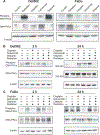Combined EGFR1 and PARP1 Inhibition Enhances the Effect of Radiation in Head and Neck Squamous Cell Carcinoma Models
- PMID: 32936912
- PMCID: PMC7682633
- DOI: 10.1667/RR15480.1
Combined EGFR1 and PARP1 Inhibition Enhances the Effect of Radiation in Head and Neck Squamous Cell Carcinoma Models
Abstract
Head and neck squamous cell carcinoma (HNSCC) is a challenging cancer with little change in five-year overall survival rate of 50-60% over the last two decades. Radiation with or without platinum-based drugs remains the standard of care despite limited benefit and high toxicity. HNSCCs often overexpress epidermal growth factor receptor (EGFR) and inhibition of EGFR signaling enhances radiation sensitivity by interfering with repair of radiation-induced DNA breaks. Poly (adenosine diphosphate-ribose) polymerase-1 (PARP1) also participates in DNA damage repair, but its inhibition provides benefit in cancers that lack DNA repair by homologous recombination (HR) such as BRCA-mutant breast cancer. HNSCCs in contrast are typically BRCA wild-type and proficient in HR repair, making it challenging to apply anti-PARP1 therapy in this model. A recently published study showed that a combination of EGFR and PARP1 inhibition induced more DNA damage and greater growth control than each single agent in HNSCC cells. This led us to hypothesize that a combination of EGFR and PARP1 inhibition would enhance the efficacy of radiation to a greater extent than each single agent, providing a rationale for paradigm-shifting combinatorial approaches to improve the standard of care in HNSCC. Here, we report a proof-of-concept study using Detroit562 HNSCC cells, which are proficient for DNA repair by both HR and non-homologous end joining (NHEJ) mechanisms. We tested the effect of adding cetuximab and/or olaparib (inhibitors of EGFR and PARP1, respectively) to radiation and compared it to that of cisplatin and radiation combination, which is the standard of care. Our results demonstrate that the combination of cetuximab and olaparib with radiation was superior to the combination of any single drug with radiation in terms of induction of unrepaired DNA damage, induction of senescence, apoptosis and clonogenic death, and tumor growth control in mouse xenografts. Combined with our recently published phase I safety data on cetuximab/olaparib/radiation triple combination, the data reported here demonstrate a potential for combining biologically-based therapies that might optimize radiosensitization in HNSCC.
©2020 by Radiation Research Society. All rights of reproduction in any form reserved.
Figures






References
-
- Loo SW, Geropantas K, Roques TW. DeCIDE and PARADIGM: Nails in the coffin of induction chemotherapy in head and neck squamous cell carcinoma? Clin Transl Oncol 2013;15:248–51. - PubMed
-
- Gu F, Ma Y, Zhang Z, Zhao J, Kobayashi H, Zhang L, et al. Expression of Stat3 and Notch1 is associated with cisplatin resistance in head and neck squamous cell carcinoma. Oncol Rep 2010; 23:671–6. - PubMed
-
- Curran D, Giralt J, Harari PM, Ang KK, Cohen RB, Kies MS, et al. Quality of life in head and neck cancer patients after treatment with high-dose radiotherapy alone or in combination with cetuximab. J Clin Oncol 2007; 25:2191–7. - PubMed
Publication types
MeSH terms
Substances
Grants and funding
LinkOut - more resources
Full Text Sources
Medical
Research Materials
Miscellaneous

